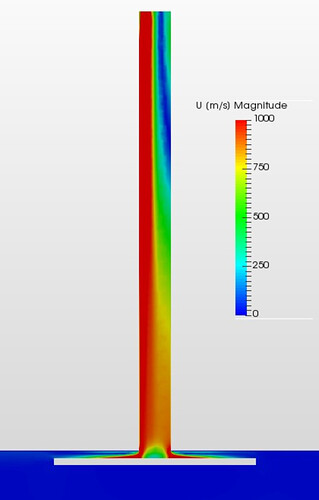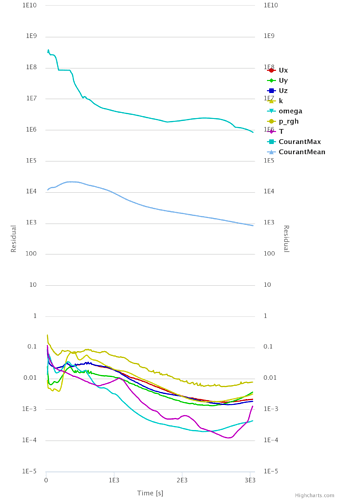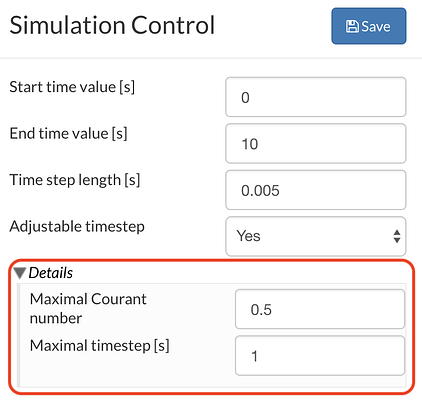@azmelfadzil, yes running a transient simulation will take a long time in your case. The reason is the refinement level on the inlets being so fine to capture the detail, in contrast, the velocity and cell size in the midsection would give a very low courant number and therefore, the courant mean is very low and the courant max is high (approximately 0.7). This is a good indication that the small timesteps are due to local refinement. So your options to speed up sim time are:
- Increase the inlet diameters to allow a coarser mesh (most likely not plausible as the design is set)
- Reduce mesh fineness and rely on wall inflation to give longer cells along the inlet (Best option IMO)
- Persevere with long solve times (at this rate you will use all core hours before it finishes)
Also, I noticed this in your log:
Time = 5.21883520648
diagonal: Solving for rho, Initial residual = 0, Final residual = 0, No Iterations 0
PIMPLE: iteration 1
DILUPBiCG: Solving for Ux, Initial residual = 0.000228965005081, Final residual = 4.65944785789e-08, No Iterations 1
DILUPBiCG: Solving for Uy, Initial residual = 6.57670160256e-05, Final residual = 1.88060413802e-08, No Iterations 1
DILUPBiCG: Solving for Uz, Initial residual = 0.000237544242542, Final residual = 4.56967381546e-08, No Iterations 1
DILUPBiCG: Solving for h, Initial residual = 4.31390217522e-06, Final residual = 4.31390217522e-06, No Iterations 0
DICPCG: Solving for p_rgh, Initial residual = 0.86259815061, Final residual = 0.00852855212221, No Iterations 141
diagonal: Solving for rho, Initial residual = 0, Final residual = 0, No Iterations 0
time step continuity errors : sum local = 2.31113354054e-08, global = 3.75739473196e-09, cumulative = -1.11793259451e-06
PIMPLE: iteration 2
DILUPBiCG: Solving for Ux, Initial residual = 0.000614955008655, Final residual = 2.7366729585e-07, No Iterations 1
DILUPBiCG: Solving for Uy, Initial residual = 8.15662048865e-05, Final residual = 3.13228806837e-08, No Iterations 1
DILUPBiCG: Solving for Uz, Initial residual = 0.000629081856036, Final residual = 2.29218901758e-07, No Iterations 1
DILUPBiCG: Solving for h, Initial residual = 8.3972983374e-06, Final residual = 8.3972983374e-06, No Iterations 0
DICPCG: Solving for p_rgh, Initial residual = 0.673074697906, Final residual = 0.00665125091491, No Iterations 9
diagonal: Solving for rho, Initial residual = 0, Final residual = 0, No Iterations 0
time step continuity errors : sum local = 1.43444759189e-08, global = 3.617096382e-09, cumulative = -1.11431549813e-06
DILUPBiCG: Solving for omega, Initial residual = 9.91959535527e-06, Final residual = 9.91959535527e-06, No Iterations 0
DILUPBiCG: Solving for k, Initial residual = 2.11488131674e-05, Final residual = 5.17521087506e-07, No Iterations 1
bounding k, min: -3.81004897356e-06 max: 0.000835148885464 average: 3.01735840141e-06
PIMPLE: not converged within 2 iterations
ExecutionTime = 81581.65 s ClockTime = 82921 s
Courant Number mean: 0.00025597738298 max: 0.70129914236
deltaT = 0.00208412875748
This means that each timestep is not converging before it moves on, if you increase the number of correctors in numerics then this will likely go away at the expense of computation time. I set mine to 20 however it does stop iterating if convergence is met so it wont always do 20 it will likely drop down to 5 or less (at the momment you are using just 2)
Hope all this helps, and let me know how it goes.
Darren


 .
.

